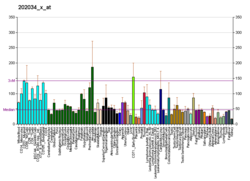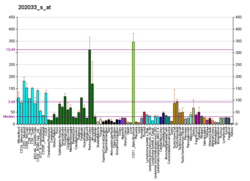RB1CC1
Jump to navigation
Jump to search
RB1-inducible coiled-coil protein 1 is a protein that in humans is encoded by the RB1CC1 gene.[5][6][7][8]
Interactions
RB1CC1 has been shown to interact with PTK2B,[9] ASK1[10] and PTK2.[9]
References
- ^ a b c GRCh38: Ensembl release 89: ENSG00000023287 – Ensembl, May 2017
- ^ a b c GRCm38: Ensembl release 89: ENSMUSG00000025907 – Ensembl, May 2017
- ^ "Human PubMed Reference:". National Center for Biotechnology Information, U.S. National Library of Medicine.
- ^ "Mouse PubMed Reference:". National Center for Biotechnology Information, U.S. National Library of Medicine.
- ^ Chano T, Ikegawa S, Kontani K, Okabe H, Baldini N, Saeki Y (Feb 2002). "Identification of RB1CC1, a novel human gene that can induce RB1 in various human cells". Oncogene. 21 (8): 1295–8. doi:10.1038/sj.onc.1205171. PMID 11850849. S2CID 1446211.
- ^ Maucuer A, Camonis JH, Sobel A (Apr 1995). "Stathmin interaction with a putative kinase and coiled-coil-forming protein domains". Proceedings of the National Academy of Sciences of the United States of America. 92 (8): 3100–4. Bibcode:1995PNAS...92.3100M. doi:10.1073/pnas.92.8.3100. PMC 42112. PMID 7724523.
- ^ Hara T, Takamura A, Kishi C, Iemura S, Natsume T, Guan JL, Mizushima N (May 2008). "FIP200, a ULK-interacting protein, is required for autophagosome formation in mammalian cells". The Journal of Cell Biology. 181 (3): 497–510. doi:10.1083/jcb.200712064. PMC 2364687. PMID 18443221.
- ^ "Entrez Gene: RB1CC1 RB1-inducible coiled-coil 1".
- ^ a b Ueda H, Abbi S, Zheng C, Guan JL (Apr 2000). "Suppression of Pyk2 kinase and cellular activities by FIP200". The Journal of Cell Biology. 149 (2): 423–30. doi:10.1083/jcb.149.2.423. PMC 2175150. PMID 10769033.
- ^ Gan B, Peng X, Nagy T, Alcaraz A, Gu H, Guan JL (Oct 2006). "Role of FIP200 in cardiac and liver development and its regulation of TNFalpha and TSC-mTOR signaling pathways". The Journal of Cell Biology. 175 (1): 121–33. doi:10.1083/jcb.200604129. PMC 2064504. PMID 17015619.
Further reading
- Nagase T, Seki N, Ishikawa K, Ohira M, Kawarabayasi Y, Ohara O, Tanaka A, Kotani H, Miyajima N, Nomura N (Oct 1996). "Prediction of the coding sequences of unidentified human genes. VI. The coding sequences of 80 new genes (KIAA0201-KIAA0280) deduced by analysis of cDNA clones from cell line KG-1 and brain". DNA Research. 3 (5): 321–9, 341–54. doi:10.1093/dnares/3.5.321. PMID 9039502.
- Ueda H, Abbi S, Zheng C, Guan JL (Apr 2000). "Suppression of Pyk2 kinase and cellular activities by FIP200". The Journal of Cell Biology. 149 (2): 423–30. doi:10.1083/jcb.149.2.423. PMC 2175150. PMID 10769033.
- Chano T, Kontani K, Teramoto K, Okabe H, Ikegawa S (Jul 2002). "Truncating mutations of RB1CC1 in human breast cancer". Nature Genetics. 31 (3): 285–8. doi:10.1038/ng911. PMID 12068296. S2CID 23884140.
- Chano T, Ikegawa S, Saito-Ohara F, Inazawa J, Mabuchi A, Saeki Y, Okabe H (May 2002). "Isolation, characterization and mapping of the mouse and human RB1CC1 genes". Gene. 291 (1–2): 29–34. doi:10.1016/S0378-1119(02)00585-1. PMID 12095676.
- Chano T, Saeki Y, Serra M, Matsumoto K, Okabe H (Aug 2002). "Preferential expression of RB1-inducible coiled-coil 1 in terminal differentiated musculoskeletal cells". The American Journal of Pathology. 161 (2): 359–64. doi:10.1016/S0002-9440(10)64190-9. PMC 1850752. PMID 12163359.
- Abbi S, Ueda H, Zheng C, Cooper LA, Zhao J, Christopher R, Guan JL (Sep 2002). "Regulation of focal adhesion kinase by a novel protein inhibitor FIP200". Molecular Biology of the Cell. 13 (9): 3178–91. doi:10.1091/mbc.E02-05-0295. PMC 124151. PMID 12221124.
- Kontani K, Chano T, Ozaki Y, Tezuka N, Sawai S, Fujino S, Saeki Y, Okabe H (Nov 2003). "RB1CC1 suppresses cell cycle progression through RB1 expression in human neoplastic cells". International Journal of Molecular Medicine. 12 (5): 767–9. doi:10.3892/ijmm.12.5.767. PMID 14533007.
- Bamba N, Chano T, Taga T, Ohta S, Takeuchi Y, Okabe H (Oct 2004). "Expression and regulation of RB1CC1 in developing murine and human tissues". International Journal of Molecular Medicine. 14 (4): 583–7. doi:10.3892/ijmm.14.4.583. PMID 15375585.
- Watanabe R, Chano T, Inoue H, Isono T, Koiwai O, Okabe H (Sep 2005). "Rb1cc1 is critical for myoblast differentiation through Rb1 regulation". Virchows Archiv. 447 (3): 643–8. doi:10.1007/s00428-004-1183-1. PMID 15968549. S2CID 21517958.
- Gan B, Melkoumian ZK, Wu X, Guan KL, Guan JL (Aug 2005). "Identification of FIP200 interaction with the TSC1-TSC2 complex and its role in regulation of cell size control". The Journal of Cell Biology. 170 (3): 379–89. doi:10.1083/jcb.200411106. PMC 2171462. PMID 16043512.
- Melkoumian ZK, Peng X, Gan B, Wu X, Guan JL (Aug 2005). "Mechanism of cell cycle regulation by FIP200 in human breast cancer cells". Cancer Research. 65 (15): 6676–84. doi:10.1158/0008-5472.CAN-04-4142. PMID 16061648.
- Chano T, Saji M, Inoue H, Minami K, Kobayashi T, Hino O, Okabe H (Sep 2006). "Neuromuscular abundance of RB1CC1 contributes to the non-proliferating enlarged cell phenotype through both RB1 maintenance and TSC1 degradation". International Journal of Molecular Medicine. 18 (3): 425–32. doi:10.3892/ijmm.18.3.425. PMID 16865226.
- Olsen JV, Blagoev B, Gnad F, Macek B, Kumar C, Mortensen P, Mann M (Nov 2006). "Global, in vivo, and site-specific phosphorylation dynamics in signaling networks". Cell. 127 (3): 635–48. doi:10.1016/j.cell.2006.09.026. PMID 17081983. S2CID 7827573.
- Ewing RM, Chu P, Elisma F, Li H, Taylor P, Climie S, McBroom-Cerajewski L, Robinson MD, O'Connor L, Li M, Taylor R, Dharsee M, Ho Y, Heilbut A, Moore L, Zhang S, Ornatsky O, Bukhman YV, Ethier M, Sheng Y, Vasilescu J, Abu-Farha M, Lambert JP, Duewel HS, Stewart II, Kuehl B, Hogue K, Colwill K, Gladwish K, Muskat B, Kinach R, Adams SL, Moran MF, Morin GB, Topaloglou T, Figeys D (2007). "Large-scale mapping of human protein-protein interactions by mass spectrometry". Molecular Systems Biology. 3 (1): 89. doi:10.1038/msb4100134. PMC 1847948. PMID 17353931.
- Lee YC, Yang VC, Wang TS (Sep 2007). "Use of RAPD to detect sodium arsenite-induced DNA damage in human lymphoblastoid cells". Toxicology. 239 (1–2): 108–15. doi:10.1016/j.tox.2007.06.101. PMID 17707572.





